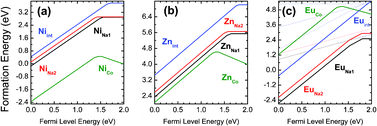Selecting the suitable dopants: electronic structures of transition metal and rare earth doped thermoelectric sodium cobaltate
Abstract
Engineered Na0.75CoO2 is considered a prime candidate to achieve high efficiency thermoelectric systems to regenerate electricity from waste heat. In this work, three elements with outmost electronic configurations, (1) an open d shell (Ni), (2) a closed d shell (Zn), and (3) a half filled f shell (Eu) with maximum unpaired electrons, were selected to outline the dopants' effects on the electronic and crystallographic structures of Na0.75CoO2. Systematic ab initio density functional calculations with DMOL3 package showed that the Ni and Zn were more stable when substituting Co with formation energy −2.35 eV, 2.08 eV when Fermi level equals the valence band maximum. While Eu is more stable when it substitutes Na having a formation energy of −2.64 eV. As these results show great harmony with existing


 Please wait while we load your content...
Please wait while we load your content...